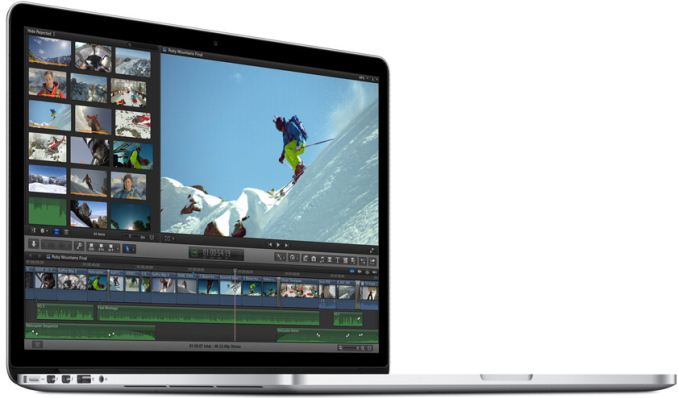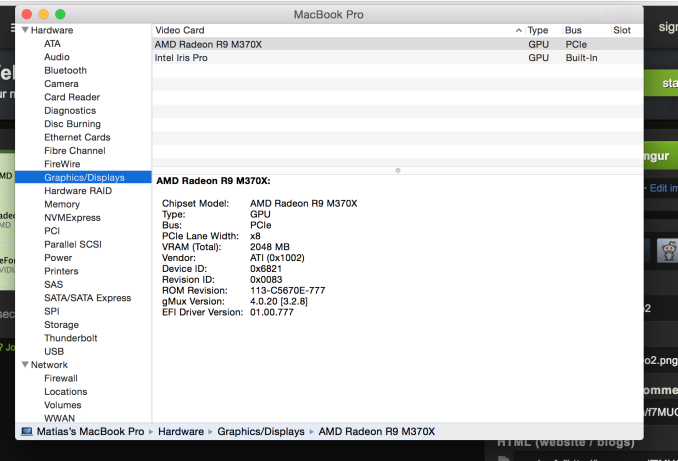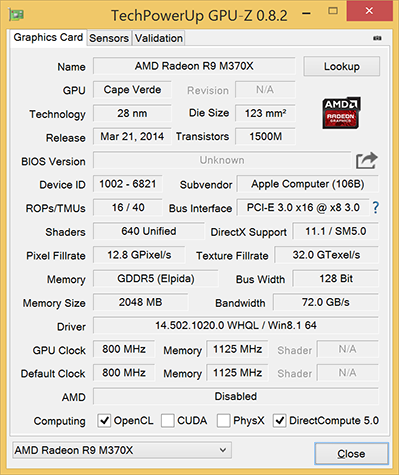2015 15-inch Retina MacBook Pro’s dGPU (R9 M370X) Is Cape Verde
by Ryan Smith on May 23, 2015 12:16 AM EST- Posted in
- GPUs
- Mac
- AMD
- Apple
- MacBook Pro
- Radeon
- Radeon 300

Earlier this week Apple announced their 2015 15” Retina MacBook Pro. Though Apple didn’t make any CPU changes, they did make some GPU changes on the high-end model, swapping out NVIDIA’s GeForce GT 750M for AMD’s Radeon R9 M370X. Since the M370X was not a published part number in AMD’s recently-announced 2015 Radeon M300 series refresh lineup, there have been some questions over just what M370X really is.
At the time of the rMBP’s launch, we suspected that it was an AMD Cape Verde GPU, based on the fact that this GPU is also in the M375, which is the next part above M370X. With the new laptop shipping immediately, M370X models have already begun arriving in buyers’ hands, finally giving us a chance to confirm the GPU inside.

Image courtesy Reddit user ootan
Thanks to Reddit user ootan, who posted a screenshot of the rMBP’s System Profiler, we can now confirm that the GPU in the rMBP is in fact AMD’s Cape Verde GPU. AMD has previously used the 6821 device ID on other mobile Cape Verde parts, so 6821 is already a known quantity.
| AMD M300 Series GPU Specification Comparison | |||||
| R9 M375 | R9 M370X (rMBP) | R7 M360 | |||
| Was | Variant of R9 M270/M260 | Variant of R9 M270X | Variant of R7 M270/M260 | ||
| Stream Processors | 640 | 640 | 384 | ||
| Texture Units | 40 | 40 | 24 | ||
| ROPs | 16 | 16 | 4? | ||
| Boost Clock | <=1015MHz | 800MHz | <=1015MHz | ||
| Memory Clock | 2.2GHz DDR3 | 4.5GHz GDDR5 | 2GHz DDR3 | ||
| Memory Bus Width | 128-bit | 128-bit | 64-bit | ||
| VRAM | <=4GB | 2GB | <=4GB | ||
| GPU | Cape Verde | Cape Verde | Oland/Topaz | ||
| Manufacturing Process | TSMC 28nm | TSMC 28nm | TSMC 28nm | ||
| Architecture | GCN 1.0 | GCN 1.0 | GCN 1.0 | ||
As for Cape Verde itself, as our regular readers may already know, it’s one of AMD’s first-generation GCN 1.0 GPUs, launched back in 2012. Compared to the GK107 GPU found in the GT 750M, it is a larger, more powerful (and at least in the desktop, more power-hungry) GPU, designed for more powerful devices than GK107 was. As for why Apple opted to switch now and to this GPU, we’ll leave that to Apple, AMD, and NVIDIA, though it’s by no means surprising that after having run GK107 for a couple of years, they would want to upgrade to a more powerful GPU.
Meanwhile, though we don’t have M370X on-hand at the moment, at least in the desktop, where GPU performance is unrestricted by thermals, Cape Verde fares very well. The rMBP on the other hand does have thermal constraints to deal with, so performance won’t be the same, but I expect it to fare reasonably well as well. Though at the same time I’m also curious if the use of a higher performance part has impacted the rMBP’s battery life when the dGPU is active; AMD and NVIDIA both do heavy binning, so a simple extrapolation won’t work here.
Update: And no sooner do I post this then someone sends me a screenshot of GPU-Z from a 15" rMBP running Boot Camp.
GPU-Z, for those unfamiliar with it, uses register poking to identify GPUs, so if the device ID wasn't enough, this settles it. This also confirms the clockspeeds - 800MHz core, 4.5GHz VRAM - and that the M370X is using GDDR5, unlike it's M375 counterpart. Thank you DMDrew812.
Source: Reddit User ootan (via SH SOTN)











107 Comments
View All Comments
Taneli - Monday, May 25, 2015 - link
GCN parts work well already, although this probably reduces the need for custom kexts. HD7850 on Yosemite here.dragonsqrrl - Saturday, May 23, 2015 - link
"they could have got the same performance with 30% less heat and power with nvidia."Seeing how this is GCN 1.0, the gap is likely significantly larger than that.
tabascosauz - Saturday, May 23, 2015 - link
Be careful with that claim. Cape Verde is not the same animal as Tahiti and Hawaii.If I remember correctly, the HD 7750 was pretty competitive with the GTX 650 without the huge power consumption problem that is attributed to AMD nowadays. The HD 7770 was faster, but wasn't so far off of that.
dragonsqrrl - Saturday, May 23, 2015 - link
You seem to be getting power consumption and power efficiency confused a bit. A GPU can consume a lot of power and still be incredibly efficient. Likewise the opposite is also true, a GPU can consume little power but still be inefficient. Of course Cape Verde doesn't consume as much power as Tahiti or Hawaii in absolute terms, it also performs significantly lower. What's important is performance per W, and that won't change much with the M370X.MamiyaOtaru - Tuesday, May 26, 2015 - link
I doubt he is. perf/watt was pretty damn nice with the 7750 series, at least at the time http://www.techpowerup.com/reviews/ASUS/HD_7750/27...dragonsqrrl - Tuesday, May 26, 2015 - link
"at least at the time"Links article from over 3 years ago where the only competitive reference is Fermi...
Kjella - Saturday, May 23, 2015 - link
Mad? No. This is pure business. AMD is selling themselves cheap to get the PR from having the GPU of the top model Mac Book Pro, while the number of $2500 laptop sales of a single model is presumably rather slim. Same reason they're the ones in all the consoles and still hurting economically, if you lowball the offer you win at the expense of your margins. Their problem is that the halo effect isn't much, gamers read benchmarks and nVidia is making a killing - from January to April the share of GTX 970s in the Steam hardware survey has gone from 1.80% to 2.81%, in one quarter 1 in 100 Steam users have bought the same $300+ graphics card, most play on cheap old cards so that's massive. It's more than the total market share of AMD Radeon R9 200 Series of 0.94%, which is barely selling anymore with +0.11% in the last quarter. Add in the 960/980/Titan and nVidia has 90-95% of the high end. That HBM card really needs to be a killer if AMD wants to stay in the competition.MrSpadge - Saturday, May 23, 2015 - link
It does seem strange, indeed. On the other hand:- AMD desperately needs money, so they probably made a very good price.
- There has hardly been any progress design-wise from AMD, so apart from some features GCN 1.0, 1.1 and 1.2 perform pretty the same per clock and shader
- GM107 based mobile GPUs are likely too fast (=expensive), whereas GM108 based mobile GPUs are cirppled by 64 bit DDR3 memory busses
lefty2 - Saturday, May 23, 2015 - link
Semiaccurate actually predicted this would happen. Semiaccurate claims that Nvidia, is not only suing Samsung and Qualcomm, but also Apple for their GPU IP patents and as retaliation Apple switched to AMD GPUs:http://semiaccurate.com/2014/09/04/nvidia-sues-sam...
WinterCharm - Saturday, May 23, 2015 - link
Yeah. I cancelled my order over this. Sorry, but Apple needs to get their shit together. I'm an actual pro user who travels a LOT... I *need* a powerful GPU on the go. NEEED. Not "prefer" not "want". If they can't deliver, they don't get my money. plain and simple.